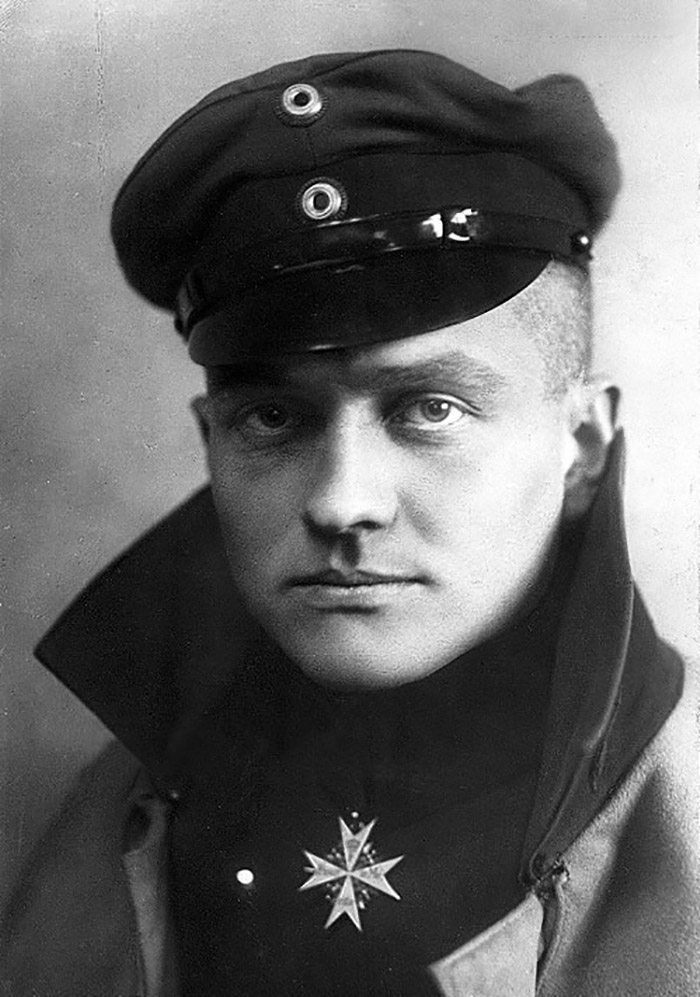In 1915, von Richthofen transferred to the Imperial German Army Air Service (Luftstreitkrafte). He studied aerial tactics under the master German strategist, Hauptman Oswald Boelcke, flying his first combat mission after less than thirty hours of flight instruction. Despite an indifferent start as a fighter pilot, he nonetheless was invited to join Boelcke’s Jagdstaffel 2 squadron and soon excelled in combat following the Boelcke Dicta, which included approaching his enemy from above with the sun behind him, firing only at close range, always keeping his eyes on his target, and attacking in a group of four to six planes.
The History of The Red Baron
At the beginning of 1917, he had 16 confirmed kills, had been awarded Germany’s highest military decoration, Pour le Merite, and was commander of a squadron, Jasta 11, of elite fighter pilots.

In April 1917 alone, he downed 22 British planes. Flying a series of Albatros aircraft, his vanity led him to have each painted red. As the German ‘Freiherr’ was translated into English as ‘Baron,’ it was but a short time until he was known to the world as ‘The Red Baron.’ His squadron was combined with three others to form Jagdgeschwader 1, widely feared as The Flying Circus. His younger brother, Lothar von Richthofen, was also a fighter pilot but far more daring than Manfred. Lothar had 40 confirmed kills and, ironically, survived the war.
The Red Baron Was Wounded in Combat
In July 1917, The Red Baron crashed in Belgium after being attacked by Captain Donald Cunnell of The Royal Flying Corps, sustaining a severe head injury, likely a skull fracture. Despite blurred consciousness and visual compromise, he had managed to land his plane. Over several months he flew occasionally and had several operations to remove bone splinters from his head wound. He suffered headaches and a distinct change in his personality, which persisted until his death.

Against medical advice, he returned to regular flying with his German air group in October of 1917, downing 18 planes until his death six months later. At the time of his death, he had downed 80 planes in all. He was the leading air ace of WWI, followed by Rene Fonck of France with 75 confirmed kills and Billy Bishop of Canada with 72. Both Fonck and Bishop lived on long after the war, each dying in the 1950s.
The Death of Manfred von Richthofen
Von Richthofen met his end on April 21, 1918, in somewhat unusual circumstances. While pursuing a Canadian pilot with little experience and at a very low altitude (Lieutenant Wilfrid May) in a Sopwith Camel, he was chased away by a seasoned Canadian pilot (Captain Arthur Brown) who dived steeply and fired at him before climbing to avoid crashing into the ground. The Baron resumed his pursuit of May but shortly, facing concentrated fire from Australian troops on the ground, he made a rough landing in a field near The Somme River. The soldiers, who had fired on his plane from the ground, got to his wrecked red Fokker triplane quickly and may or may not have heard his last words, which, allegedly, included the word kaput. Exact accounts of damage to his plane by gunfire— before it was dismantled by soldiers seeking souvenirs— are not found.

His body was taken to an Australian Flying Corps hangar at Poulainville, washed by a corpsman, and shortly examined by at least four medical officers. The body was not opened. An entrance wound and an exit wound were superficially identified and probed with a fence wire. Subsequent reports by two of these men— one a colonel and the other a captain— are not congruent. The most plausible conclusion of his body’s several viewings, immediately and a bit later, suggest that a single bullet entered von Richthofen’s right lateral chest, passed through his right lung and heart, and exited through his left chest. Before the red Fokker airplane was scavenged, some thought that a single bullet hole on the cockpit’s right side lined up with his chest entry and exit wounds. His body was buried on April 22 in a village churchyard near Amiens, France, after a military funeral conducted by Commonwealth forces.
The Baron’s Orders and Decorations
The myths and mystique associated with Manfred von Richthofen and his death resulted in an immediate and continuing fascination with the press and other media. Captain Arthur Brown received a bar to his Distinguished Flying Cross but not the Victoria Cross, earlier allegedly promised by Britain for the man who killed The Red Baron.
Despite many claimants, no Australian gunner received any decoration for causing von Richthofen’s end, as it was unclear who fired the fatal shot. The best scenario for the death of von Richthofen gives credit to Sergeant Cedric Popkin of the 24th Machine Gun Company of the First Australian Imperial Force, who opened fire with his Vickers machine gun on the red Fokker DR1 triplane as it banked to the left and fled to avoid fire from Lewis guns operated by Robert Buie and Snowy Evans. It can be assumed that The Red Baron’s flying skills were quite intact on April 21, for he had downed two enemy planes just the day before.
There was no glamour in trench warfare and precious few heroes. By contrast, aerial warfare was the stuff of gallant knights of the air dueling in single combat far above the mud, misery, and mortality of the trenches far below them. That Baron von Richthofen was almost surely brought to his death barely above these trenches by a plucky Australian machine gunner remains a great irony of The Great War.

0 Comments